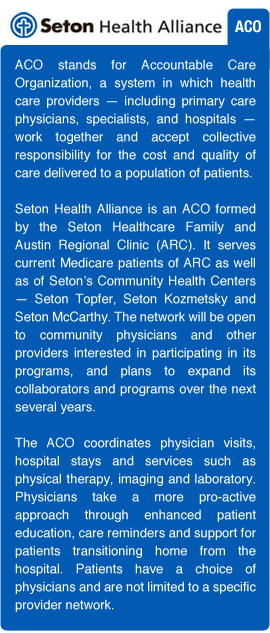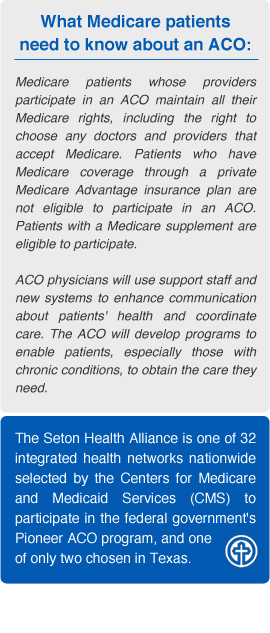![]() After 10 years in the acute health care field and a lifetime of experience as a patient or relative of one, I know there is room for improvement.
After 10 years in the acute health care field and a lifetime of experience as a patient or relative of one, I know there is room for improvement.
| Four Ways > Healthy Central Texas | |
|---|---|
| 1. Collaborate on care | |
| 2. Talk about healthy behaviors | |
| 3. Go where the patients are | |
| 4. Provide doctors with better training |
Central Texas pays a steep financial and personal price for the provider-centric model of health care and services that evolved over time. There simply hasn’t been adequate incentive for care providers to pursue strategies that keep you well. Because healthcare providers receive payment based on the volume of work we do, and not the value we deliver, health costs are taking an increasing bite out of our budgets. Individuals, employers and private and public payers have said: “Enough. Find a better way.”
Seton’s vision is to care well for Central Texans, but also to work more diligently to help you stay out of the hospital. We are testing new ways to deliver care, several in concert with other organizations that share our mission to serve people who don’t have insurance, can’t drive to the doctor or hit other barriers to timely care. Our efforts are fueled by our community’s health status.
- Texas health care costs increased 36.1 percent from 2005 to 2009 — an increase almost four times the rate of inflation and more than four times the rate of population growth. Our state trails the nation in many indicators of health.
- Seventy-five percent of health care spending is due to chronic and often preventable diseases, such as obesity-related diabetes and heart disease.
- The conditions of people who don’t have the means to receive timely care from a primary care doctor or clinic eventually deteriorate to the emergency stage. Any health care journey that starts in the Emergency Room is going to be expensive. When patients cycle through ERs on a regular basis, the tab for taxpayers balloons.
- Every dollar of the state and local treasury that must be spent on treating preventable conditions is a dollar that we cannot invest in our schools and higher education, research and development, roads and other services that improve everyone’s quality of life.
- Eight out of 11 Central Texas counties have fewer than five psychiatrists, and five of those have none.
- Demographic trends in Central Texas suggest that we will continually face increasing costs unless we change the way people receive the care they need.
The Seton Healthcare Family is collaborating with Central Health and others in four ways to create a true system of care for Central Texas, a coordinated approach that helps patients stay healthier, heal more quickly and spend less on care.
1. Collaborate on care
Today’s broad array of primary and specialized medicine creates a complex maze of care that, if not navigated, can isolate an individual. Seton Healthcare Family is testing an integrated care approach, starting with a focus on patients with complex needs, including seniors and those with chronic conditions such as congestive heart failure.
By proactively managing the health of patients who frequently use health care services, Seton hopes to improve their health in an active and sustainable way. For example, when we reviewed data about patients who regularly seek emergency care and require hospital admission — the most expensive type of health care — we found that many lack social support to manage chronic conditions. We created a multidisciplinary clinic of nurse navigators, social workers and doctors trained in complex cases to help these patients manage their health and avoid unnecessary emergency and hospital care.
Among a test group of patients compared to a control group, this model shows promise in reducing inpatient and emergency admissions and readmissions, as well as the overall cost of care.
Likewise, Seton Health Alliance, an Accountable Care Organization (ACO), permits doctors and hospitals to collaborate on a patient’s care plan, something that was previously barred by law. Providers are paid based on patient outcomes and efficiency. This team approach, applied to specific populations with complex needs, catches problems earlier in the disease cycle, eliminates duplicative diagnostic tests, improves a patient’s experience of treatment and has a positive influence on the health of the community.
2. Talk about healthy behaviors
Thirty-five percent of students in the Austin Independent School District are overweight or obese
To tackle this problem, we must encourage members of the community to adopt new routines. The Texas Center for Treatment and Prevention of Childhood Obesity at Dell Children’s Medical Center offers two programs: a clinic for overweight and obese children and teens, and an English/Spanish after-school program for families. Both programs are designed to instill lifelong healthy routines.
To stimulate a community-wide conversation about eating habits and our environment, Children’s Optimal Health has been mapping areas of Austin with high incidences of obesity, few recreational facilities and food deserts — areas with limited access to fresh produce, but easy access to high-fat snacks and fast food. With this information, neighborhood associations can apply strategies that encourage healthier lifestyles.
3. Go where the patients are
As our region grows in both area and population, it can be more difficult for people to travel to medical facilities for routine preventive procedures, especially for the working poor, who often hold two or more jobs.
Seton has returned to the timeless model of bringing care and services to people.
Perhaps the most eye-catching example is Seton’s Big Pink Bus, a mammoth polka-dotted digital mammography clinic on wheels. The van visits a network of nonprofit partners to ensure that low-income and uninsured women in five Central Texas counties have access to breast cancer screening.
Other ways to make quality care more accessible to everyone are to increase the supply of doctors locally and attract some of the top specialists in the country to teach new doctors in Central Texas. That is why Seton is an enthusiastic supporter of Travis County Proposition 1 on the Nov. 6 ballot. Tax dollars would be used to fund the operation of a research-focused medical school built by The University of Texas-Austin, easily accessible by bus.
Some say we have enough physicians, and certainly our community is blessed with an abundance of superb cardiologists and surgeons. However, because our population is growing and gaining seniors faster than other parts of the country, Central Texas requires other types of doctors — about 770 physicians in four years to meet demand.
Demand for the primary care doctors and specialists the elderly require is acute. Texas A&M Health Science Center in Round Rock is training many of the region’s future primary care physicians. However, patients with conditions like arthritis and kidney disease experience lengthy waits for doctors, and some whose medical bills are paid by Medicare or Medicaid will never receive care.
Seton Healthcare Family spends about $45 million a year to train new specialists because physicians in training are one of the most cost-effective ways to deliver care.
If our community passes Proposition 1 on Nov. 6, medical experts will flock to Austin to teach in area clinics and provide care for those with little or no health insurance. Indeed, several already have. They came to connect medical education to UT’s renowned research infrastructure. Their presence here also reduces the need for patients with means to travel to other cities for cutting edge care. In fact, patients from other counties and states have begun following top pediatric, heart, pulmonary and neurology talent to Austin for treatment.
4. Provide doctors with better training
In one way, we are fortunate to be late in building a medical school in Austin. It gives us an opportunity to improve on the old paradigm.
We now know that to attend safely and affordably to patients, care givers of all types must coordinate their efforts, what we call person-centered care. Unfortunately, that’s not the way the majority of clinicians have been trained. So, when doctors, nurses, therapists and technologists come to work at a hospital, they often require training in how to work — and speak — as part of a multidisciplinary team.
Seton already provides multidisciplinary simulation training at the Clinical Education Center we created at the public University Medical Center Brackenridge five years ago. We also hope to pay for the replacement of Brackenridge with a 21st century teaching hospital. Our vision, together with UT Austin and Central Health, is to train doctors and all members of the clinical team to provide the type of coordinated care that benefits our entire growing and changing community.
I hope you will share Seton’s vision to care well — and affordably — for all Central Texans.
What can you do?
- Encourage you, your family and friends to get active or find a weight management program that works.
- Insist that your care providers work together on your behalf. Whether it's cross-checking your routine prescription medicines or sparing you duplicate diagnostic tests, providers can do better. Hold us accountable!






















